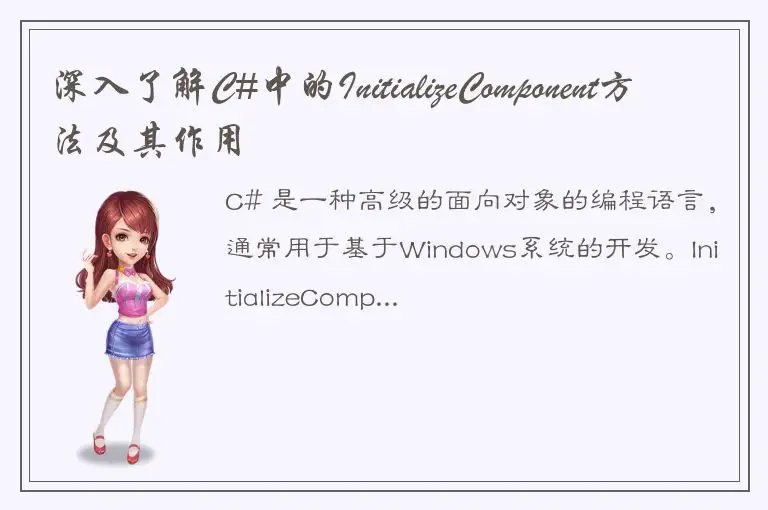C# 是一种高级的面向对象的编程语言,通常用于基于Windows系统的开发。InitializeComponent() 方法是 C# 程序中的一个很重要的方法之一,它是自动生成的用于构造窗体或者控件的方法。在 C# 中,GUI 界面是通过初始化组件 (InitializeComponent() 方法) 来实现的。本文将带您深入了解 C# 中的 InitializeComponent 方法及其作用。

1. InitializeComponent 方法的概念及作用
InitializeComponent() 方法是一个在 Windows 应用程序中固定使用的方法,该方法被用来初始化一个 Windows Form 窗体或者 User Control 控件,并填充窗体或者控件的元素,例如按钮、标签、文本框等。通过该方法的调用,可以将主界面及其控件初始化为整个应用程序的初始状态。
在代码中,我们很常见到以下的代码段:
```csharp
public partial class MainForm : Form
{
public MainForm()
{
InitializeComponent();
}
}
```
这里 `MainForm()` 是类的构造函数。构造函数是一个在实例化类时执行的方法,该方法必须与类名称相同,且没有返回类型。在 `MainForm()` 构造函数中调用了初始化组件 `InitializeComponent()` 方法,从而完成控件的初始化。
2. InitializeComponent 方法的自动生成
在 Visual Studio 中,我们只需要通过拖拽控件到窗体上, IDE 就会帮我们自动生成该控件的代码。在 XAML 中,控件的定义和初始化是一体化的,不需要单独的初始化方法。
但是,在 C# 中,我们需要通过手动为每个控件与元素编写代码来实现控件的初始化。手动编写代码虽然有些麻烦,但是其灵活性和控制能力要高于自动生成代码。同时,由于初始化组件方法 `InitializeComponent()` 自动编写,因此我们无需深究其具体实现流程。
3. InitializeComponent 方法的实现流程
由于 `InitializeComponent()` 方法是由系统自动生成并编写的,因此我们可以通过查看其具体实现代码,来了解其初始化控件的流程。
以一个简单的窗体为例,`InitializeComponent()` 方法的代码如下所示:
```csharp
private void InitializeComponent()
{
this.label1 = new System.Windows.Forms.Label();
this.button1 = new System.Windows.Forms.Button();
this.SuspendLayout();
//
// label1
//
this.label1.AutoSize = true;
this.label1.Font = new System.Drawing.Font("宋体", 12F, System.Drawing.FontStyle.Bold, System.Drawing.GraphicsUnit.Point, ((byte)(134)));
this.label1.Location = new System.Drawing.Point(89, 42);
this.label1.Name = "label1";
this.label1.Size = new System.Drawing.Size(89, 20);
this.label1.TabIndex = 0;
this.label1.Text = "Hello!";
//
// button1
//
this.button1.Location = new System.Drawing.Point(93, 107);
this.button1.Name = "button1";
this.button1.Size = new System.Drawing.Size(75, 23);
this.button1.TabIndex = 1;
this.button1.Text = "Say Hi";
this.button1.UseVisualStyleBackColor = true;
this.button1.Click += new System.EventHandler(this.button1_Click);
//
// Form1
//
this.AutoScaleDimensions = new System.Drawing.SizeF(8F, 15F);
this.AutoScaleMode = System.Windows.Forms.AutoScaleMode.Font;
this.ClientSize = new System.Drawing.Size(282, 255);
this.Controls.Add(this.button1);
this.Controls.Add(this.label1);
this.Name = "Form1";
this.Text = "Hello World";
this.ResumeLayout(false);
this.PerformLayout();
}
```
在该方法的实现流程中,首先是声明了 `Label1` 和 `Button1` 两个控件。其次是分别对这两个控件的属性进行了初始化,如标签 `label1` 的字体、位置、边框等;按钮 `button1` 的位置、名称、大小、事件等。最后将两个控件加入窗体中。
按照以上流程, `InitializeComponent()` 方法完成了窗体和控件的初始化和添加的工作。因此,在应用程序启动时,该方法会被自动调用并执行,从而将窗体和控件初始化为整个应用程序的初始状态。
4. 小结
InitializeComponent() 方法是 C# 程序中的一个很重要的方法之一,它能够自动帮我们初始化窗体和控件,为代码编写和窗口控件的管理带来很大的便捷性。在 C# 中,我们需要手动为每个控件编写代码,将其添加到相应的窗体或容器中。通过深入了解 Initializecomponent() 方法的作用和实现过程,我们能够更加熟练快速地掌握该方法,进一步提升应用程序开发效率。




 QQ客服专员
QQ客服专员 电话客服专员
电话客服专员